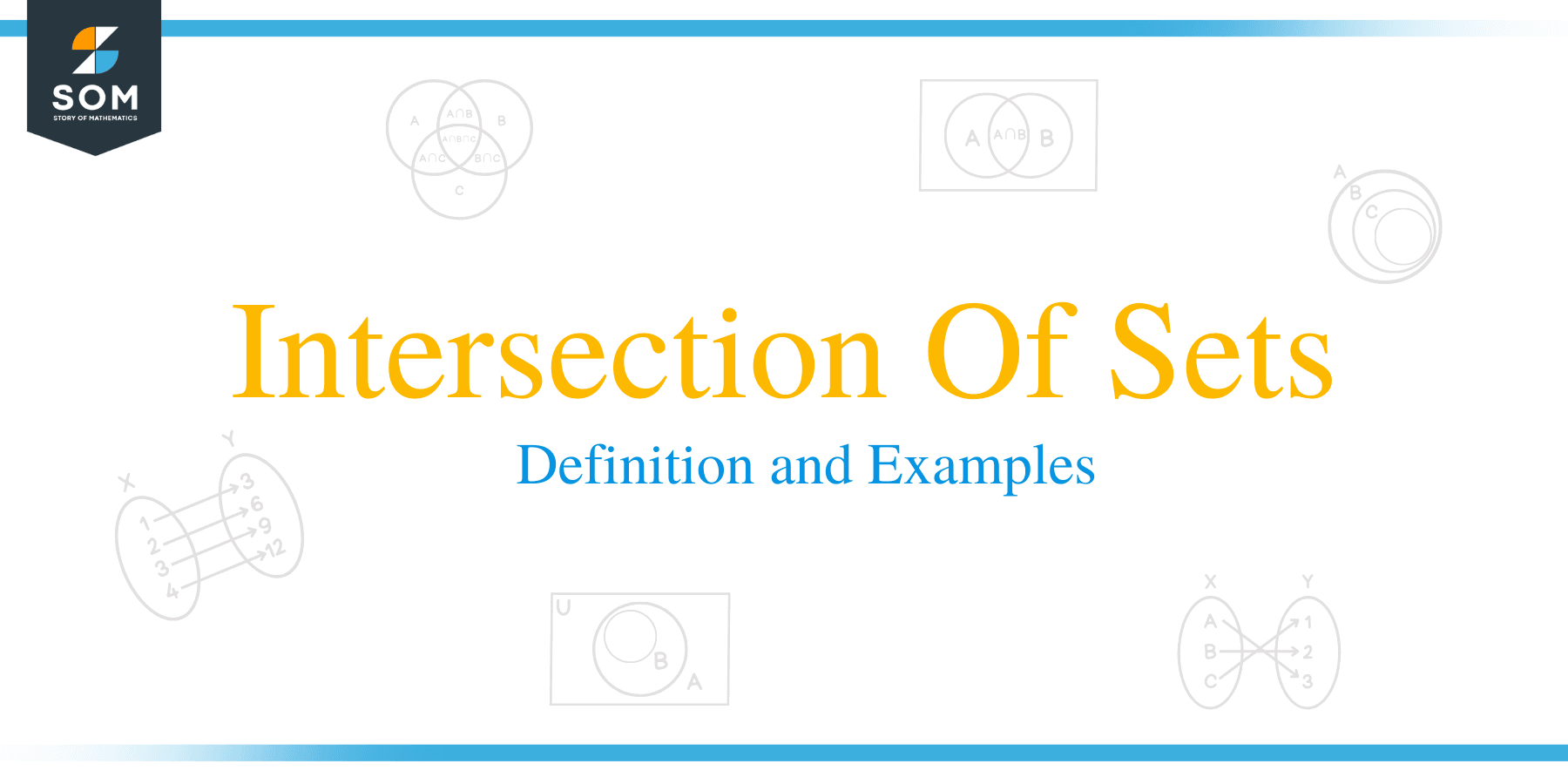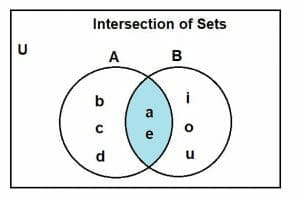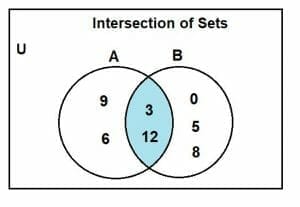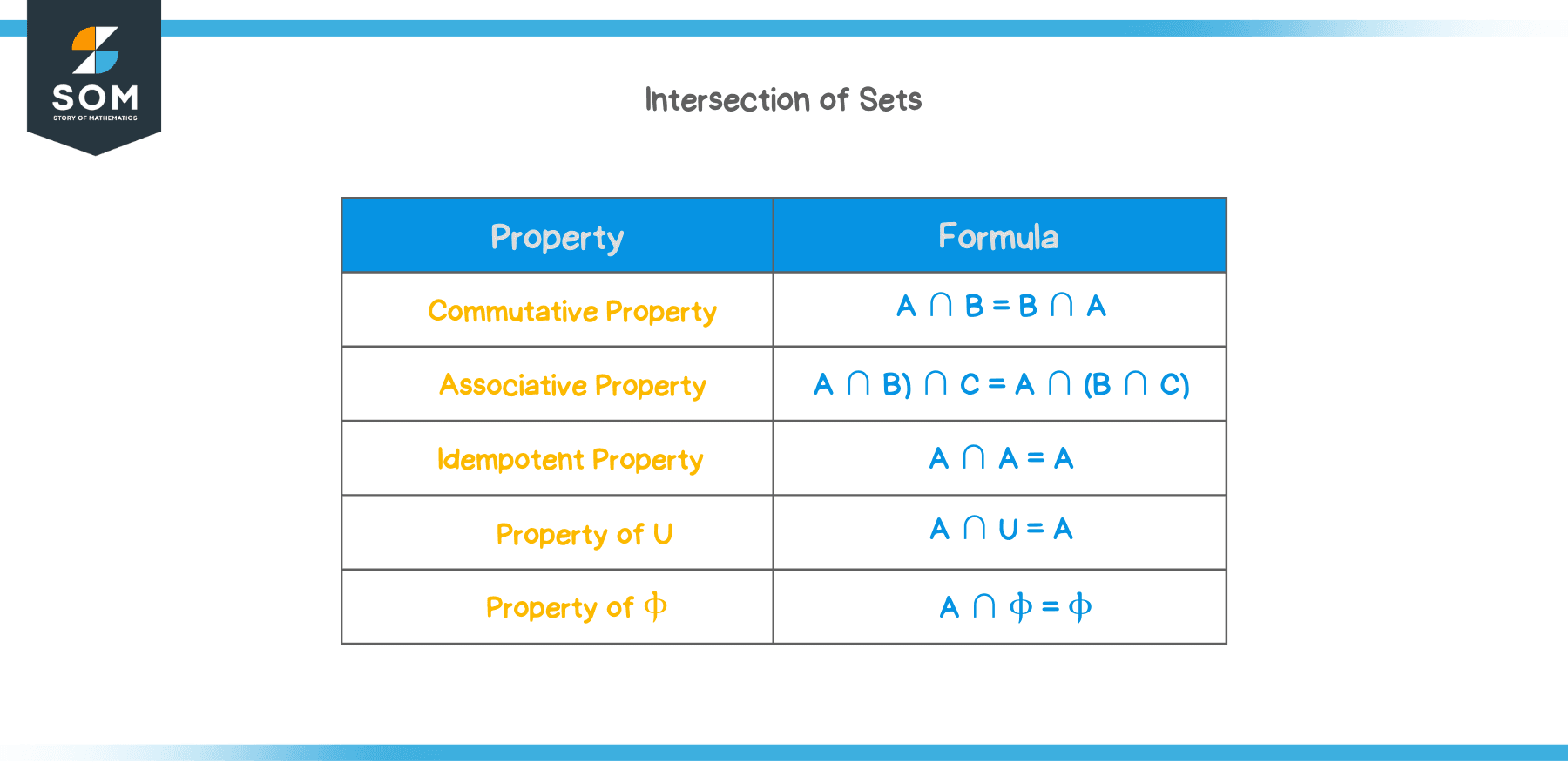- Home
- >
- Intersection of sets – Definition and Examples
JUMP TO TOPIC
Intersection Of Sets – Definition and Examples
 The concept of intersection is not only limited to set theory. It is, in fact, a widespread mathematical concept. It is one of the prevalent concepts of Euclidean geometry and set theory. Intuitively speaking, whenever we intersect two or more objects, it usually results in a smaller object.
The concept of intersection is not only limited to set theory. It is, in fact, a widespread mathematical concept. It is one of the prevalent concepts of Euclidean geometry and set theory. Intuitively speaking, whenever we intersect two or more objects, it usually results in a smaller object.
However, in set theory, the intersection is another operation. We know that we can combine different sets in various ways to produce more sets. These combinations are called an operation. An operation is an activity where we can combine different sets to form a new set with specific properties.
In this lecture, we will discuss the operation known as the Intersection of Sets.
The intersection of sets A and B can be defined as a new set containing common elements of A and B.
In this article, we will be covering the following topics:
- What is the intersection of sets?
- Notation of the intersection of sets.
- Representation of intersection of sets through Venn diagrams.
- Intersecting Vs. Disjoint sets.
- Properties of intersecting sets.
- Examples
- Practice Problems
Before moving forward, you may consider refreshing your knowledge on the following prerequisites:
What is the Intersection of Sets?
Whenever we talk about the intersection between two sets, it means a resultant set containing all the common elements between these two sets. Alternatively, we can also say that it contains all the elements of one set that also belong to the other set.
Let us assume we have two sets, A and B, then their intersection results in a new set containing all the common elements between A and B.
If we talk in terms of mathematics, any element is a part of the intersection if and only if it is an element of both the sets involved (or more).
We will be discussing the properties of intersection further into the lecture but for now, let’s stick to understanding that intersection is an associative and commutative operation.
Example 1
You are given two sets, defined as follows:
A = {1, 4, 8, 9}
B = {3, 4, 9}
Write down the intersection of the sets.
Solution:
As we know, that intersection of two sets is the set containing the common elements of both the sets; therefore, our new set is going to be:
{4, 9}
We can observe that 4 and 9 are the only common elements to both A and B. So the set which contains both these elements will be the intersection of sets.
The Notation for Intersection of Sets
Delving further into the intersection of sets, our next step is to talk about the notation used to represent sets’ intersection. The intersection between any two sets, A and B, is represented by the symbol ‘∩’. Like the symbol used for the union of sets, this symbol is used between the operands. The operands, in this case, are the names denoting the sets.
This method of notation is called the ‘infix notation.’ In this notation, the operator is surrounded by the operands. The operator, in our case, is ‘∩’. It is, most commonly, used to refer to binary operations. We know that intersection, as the union of sets, is also a binary operation.
An example of this would be as follows:
A = {0, 0, 0, 4}
B = {2, 6, 9}
Then the intersection of these sets is denoted by:
A ∩ B
So, whenever we want to express the intersection between two sets, this is how we do it symbolically. It is an expression of set A intersecting set B.
Let’s solve some examples to understand the intersection of sets.
Example 2
If sets A and B are defined as:
A = {1, 12, 14, 11, 13, 7, 9, 17, 19}
B = {12, 15, 14, 2, 1, 6, 9, 0}
Find out the intersection of set A and B.
Solution:
The intersection of two sets is defined as the set containing elements in set A which are also present in set B; in other words, the common elements.
As we can see, 12, 14, 1, 9 are the elements present in both set A and set B. So, we have the intersection of sets equal to:
A ∩ B = {12, 14, 1, 9}
Representation of Intersection using Venn Diagram
As we have highlighted time and again how important Venn diagrams are for visualizing sets and the different operations we can perform on them.
So, let’s give a quick background on Venn diagrams. Venn diagram is the most appropriate tool to understand the operations on sets in a comprehensive manner. They are used to represent finite sets only. All the region covered under a curve is represented as one set. Whereas the elements of that particular set are represented using points inside the region of the diagram.
Let us say, U represents a universal set, sets A and B are subsets of this universal set. For example, if A = {a, b, c, d, e} and B = {a, e, i, o, u}, then their intersection is as follows:
A ∩ B = {a, e}
A’ and ‘e’ are the only two common elements between sets A and B.
To represent them with a Venn diagram, we will use two circles, one for set A and one for set B. the universal set U, in this case, is the set of alphabets to which both sets A and B would belong to. Following is the Venn diagram representation of the intersection:

The shaded blue area represents the intersection between A and B.
Here, we show only two sets, a Venn Diagram of any operation can be constructed using multiple sets, as long as they are finite.
Let’s solve some examples to learn how to construct our very own Venn diagram.
Example 3
Consider a set A = {3, 6, 9, 12} and set B = {0, 3, 5, 8, 12}. Show the intersection between A and B through Venn diagram. Let set U = {set of whole numbers till 20}.
Solution:
The intersection between the two sets A and B can be determined as:
A = {3, 6, 9, 12}
And,
B = {0, 3, 5, 8, 12}
The intersection is:
A ∩ B = {3, 12}
The Venn diagram representation for the intersection between sets A and B is:

Intersecting vs Disjoint sets
The intersection between two sets is also another way of using the logic ‘AND’. This means that you can also use the word ‘AND’ to represent an intersection. But how does that translate to real-world examples?
Suppose you must find the probability of one event and another event; this is expressed using the intersection of sets. If both events’ probability of occurring together is a non-zero number, we can say the sets are intersecting. On the contrary, if the probability of both the events to occur together is zero, we say they are disjoint sets.
Let us look at the concept of disjoint sets in more clarity.
If we have two sets and some elements present in one set, which are also present in another set, we call the sets intersecting.
However, if there is no common element between the sets, they are called disjoint sets. There is no element in the intersection between the sets. For example, {4, 9, 10} and {1, 5} are disjoint sets because they have no common elements between them. Hence their intersection is a null set.
A ∩ B = Ⲫ
Properties of Intersection of Sets
We have studied several properties of other set operations; we will now look at the properties of the intersection of sets:
Commutative Property:
Any operation is considered commutative if you change the order of the operands, but this change does not affect the result.
It is one of the most fundamental properties of several binary operations. The effect of this property is that we can change the position of the operands without worrying about any discrepancies in the result.
The commutative law of intersection states that:
The result will not be affected by the order of the operating sets.
So, if we have two sets, A and B, then mathematically, the commutative property is:
A ∩ B = B ∩ A
Let’s solve an example to comprehend this.
Example 4
Given that the sets A and B are:
A = {3, 6, 9, 10}
B = {1, 3, 5, 8, 10}
Prove that the commutative property of intersection holds for them.
Solution:
Our first step is to solve for the left-hand side of the equation, which is:
A ∩ B = {3, 6, 9, 10} ∩ {1, 3, 5, 8, 10}
A ∩ B = {3, 10}
Next, we solve for the right-hand side of the equation, which is:
B ∩ A = {1, 3, 5, 8, 10} ∩ {3, 6, 9, 10}
B ∩ A = {3, 10}
From the above right and left sides of the equation, we can prove that the commutative property holds for the intersection as both the sides are equal.
Associative Property:
This property means that you can shift or reposition the parentheses without worrying about changes in the equation’s results.
As discussed for the commutative property, associativity is also a broader mathematical concept and not only confined to set theory. Like a commutative property, it is also one of the fundamental properties of binary operations. It is mainly used in proofs where rearranging any symbols is required. Essentially, associativity is concerned with the arrangement of any operands in any equation.
However, the associative law of intersection states that changing the position of parentheses in any expression of sets involving intersection operation will not affect the results in any manner whatsoever.
The grouping of sets for intersection will not affect the result.
Similarly, if we have three sets, namely A, B, and C, on which intersection is to be performed Mathematically, the associativity property of intersection is written as:
(A ∩ B) ∩ C = A ∩ (B ∩ C)
Let’s solve an example to understand this.
Example 5
Prove that the associativity property of intersection holds for the following sets:
A = {1, 5, 8}
B = {2, 5, 8, 9}
C = {1, 8, 9}
Solution:
Solving first for the left side of the equation:
(A ∩ B) = {1, 5, 8} ∩ {2, 5, 8, 9} = {5, 8}
(A ∩ B) ∩ C = {5, 8} ∩ {1, 8, 9} = {8}
Now, solving for the right side of the equation:
(B ∩ C) = {2, 5, 8, 9} ∩ {1, 8, 9} = {8, 9}
A ∩ (B ∩ C) = {1, 5, 8} ∩ {8, 9} = {8}
From the left and right sides of the equations, we can prove that the associativity property holds for the sets A, B, and C.
Idempotent Property:
The idempotent property states that the intersection of any set with itself will be given the set itself. Let us say we have a set A; then the idempotent property states that:
A ∩ A = A
We know that the common elements between two identical sets will be the original elements of the set.
Property of U:
The universal set property states that the intersection of A with the universal set will result in A.
This can be understood by thinking of A as the subset of the universal set, as the elements in A will be present in the universal set. We can say with certainty that their intersection will produce A as the intersecting set.
A ∩ U = A
Property of Ⲫ:
The null set’s property states that the intersection of any set A with a null set will result in a null set. Mathematically it can be written as:
A ∩ Ⲫ = Ⲫ
Practice Problems
- Find out the intersection of the following sets: A = {set of natural numbers}, B = {set of whole numbers}.
- Draw the Venn Diagram of intersection between A = {0, 3, 5, 7, 9, 10} and B = {2, 4, 6}.
- Explain whether the sets above are disjoint sets or intersecting sets. Give reasons.
- Using U = set of natural numbers and A = {1, 2, 3, 4, 5, 6, 7, 8} satisfy the property of U.
- If A = {a, b, e, g, j}, B = {d, h, e, g} and C = {c, g, h}. Find the intersection between:
- A and C
- B and C
- A, B and C.
Answers
- {set of natural numbers}
- Left for the reader
- Disjoint sets, no common elements
- Left for the reader
- (1): {g}, (2): {g, h}, (3):{g}
